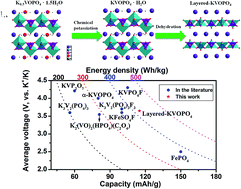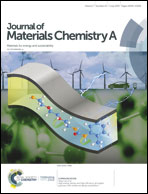Competing with other polyanionic cathode materials for potassium-ion batteries via fine structure design: new layered KVOPO4 with a tailored particle morphology†
Abstract
Layered materials with two-dimensional ion diffusion channels are attractive for fast kinetics in secondary batteries. However, it is a great challenge to tolerate the structure evolution and volume change during the insertion/extraction of large size K ions. Herein, we report new layered KVOPO4 (L-KVOP) with a controllable morphology prepared by a hydrothermal method. The L-KVOP electrodes exhibit advantageous K-storage performance, including a high average voltage of 3.65 V, a high capacity of 115 mA h g−1 (0.2C, 1C = 120 mA h g−1), considerable cycling stability with 86.8% capacity retention over 100 cycles (0.5C) and superior rate capability in potassium ion batteries. A high contribution of capacitive charge storage is revealed due to the fast ion diffusion in the bulk. The reversible structural evolution during K ion insertion/extraction is verified by ex situ X-ray diffraction, and the volume change is only 9.4%. Its superior rate performance and energy density make L-KVOP a promising candidate for potassium-ion batteries.



 Please wait while we load your content...
Please wait while we load your content...